Ireland is steeped in history and traditions, both oral and written. Anthony Bourdain sets out to not only to dispel the myths that it has the worst food on the planet, but to prove that Ireland is on the brink of becoming the world's next culinary superpower. His culinary and historic tour takes him through both Northern Ireland and the Republic of Ireland. Although ideologically and politically separated, they share a common cuisine.
Introduction:
Ireland is the third-largest island in Europe. To the east of Ireland is Great Britain, separated from it by the Irish Sea. The island is divided between the Republic of Ireland, which covers just under five-sixths of the island, and Northern Ireland, a part of the United Kingdom, which covers the remainder and is located in the northeast of the island.
Over sixty years of intermittent warfare in the 1500s during the Tudor dynasty led to English dominion after 1603. In the 1690s, a system of Protestant English rule was designed to materially disadvantage the Catholic majority and Protestant dissenters, and was extended during the 18th century. In 1801, Ireland became a part of the United Kingdom.
The Irish War of Independence in the early 20th century led to the partition of the island, creating the Irish Free State, which became increasingly sovereign over the following decades. Northern Ireland remained a part of the United Kingdom and saw much civil unrest during the period called the Troubles which lasted from the late 1960s until the 1990s. This subsided following a political agreement, the Belfast Agreement, in 1998.
While it ranks among the wealthiest countries in the world today in terms of GDP, Ireland was one of the most impoverished countries in Europe while it was a part of the United Kingdom and for decades following independence. Economic protectionism was dismantled in the late 1950s and Ireland joined the European Economic Community in 1973. Economic liberalism from the late 1980s onwards resulted in rapid economic expansion, particularly from 1995 to 2007, which became known as the Celtic Tiger period. An unprecedented financial crisis beginning in 2008 ended this era of rapid economic growth.
Today, Ireland is a constitutional republic governed as a parliamentary democracy with an elected president serving as head of state. It is a "very highly developed" country with the fifth highest Human Development Index. The country is highly ranked for press freedom, economic freedom and democracy and political freedom. Ireland is a member of the European Union, the Council of Europe, the Organisation for Economic Co-operation and Development, the World Trade Organisation and the United Nations.
Belfast
Belfast is the capital of and largest city in Northern Ireland, as well as the second largest city on the island of Ireland. In the 2001 census, the population within the city limits was 276,459, while 579,554 people lived in the wider metropolitan area, making Belfast the fifteenth-largest city in the United Kingdom.
Belfast is a centre for industry, as well as the arts, higher education and business, and is the economic engine of Northern Ireland. During the Troubles, Belfast suffered much disruption, conflict, and destruction, but has since experienced a sustained period of calm, free from the intense political violence of former years, and substantial economic and commercial growth. Nonetheless, West Belfast remains segregated by walls that separate Catholic or "Repulican" and Protestant or Loyalist neighborhoods or zones, commonly known as "peace walls", erected by the British Army after August 1969 to keep violence down, and which still divide 14 districts in the inner city. These zones are invariably marked by are invariably marked by flags, graffiti and murals.
Ethnic minority communities have been in Belfast since the 1930s. The largest groups are Chinese and Irish travellers. Since the expansion of the European Union, numbers have been boosted by an influx of Eastern European immigrants. The 2001 census showed that Belfast has a total ethnic minority population of 4,584 or 1.3% of the population. Over half of these live in south Belfast, where they comprise 2.63% of the population.
The IRA Ceasefire in 1994 and the signing of the Good Friday Agreement in 1998 have given investors increased confidence to invest in Belfast. This has led to a period of sustained economic growth and large-scale redevelopment of the city centre. Der Spiegel, a German weekly magazine for politics and economy, titled Belfast as The New Celtic Tiger which is "open for business". The Times wrote about Belfast's growing economy: "According to the region's development agency, throughout the 1990s Northern Ireland had the fastest-growing regional economy in the UK, with GDP increasing 1% per annum faster than the rest of the country.
As with any modern economy, the service sector is vital to Northern Ireland's development and is enjoying excellent growth. In particular, the region has a booming tourist industry with record levels of visitors and tourist revenues and has also established itself as a significant location for call centres." Since the ending of the regions conflict tourism has boomed in Northern Ireland, greatly aided by low cost.
Dublin
Dublin is the largest city in Ireland and the capital city of the Republic of Ireland. Dublin is situated near the midpoint of Ireland's east coast. Originally founded as a Viking settlement, it evolved into the Kingdom of Dublin and became the island's primary city following the Norman invasion. The city expanded rapidly from the 17th century, and for a brief period was the second largest city within the British Empire and the fifth largest in Europe. Following the partition of Ireland in 1922, Dublin became the capital of the Irish Free State and later of the Republic of Ireland.
As an alpha global city, Dublin is among the top 30 cities in the world. It is a historical and contemporary cultural centre for the country, as well as a modern centre of education, the arts, administration, and industry. Dublin has been at the centre of Ireland's phenomenal economic growth over the last decade (known as the Celtic Tiger period).
Since the advent of the Celtic Tiger years, however, a large number of global pharmaceutical, information and communications technology companies have located in Dublin and the Greater Dublin Area. For example, Microsoft, Google, Amazon, eBay, PayPal, Yahoo!, Facebook and Pfizer (among others) now have European headquarters and/or operational bases in the city. Banking, finance and commerce are also important in the city. Guinness has been brewed at the St. James's Gate Brewery since 1759.
Dublin has a vibrant nightlife and is reputedly one of Europe's most youthful cities, with an estimate of 50% of citizens being younger than 25. In 2009, Dublin was listed as the fourth-richest city in the world. It is also listed as the tenth most expensive city in the world in which to live.
The population of the the city was 505,739 in the 2006 census, while the population of the urban area was the metropolitan area was 1.6 million. The city's population is expanding rapidly, and it is estimated by the CSO that it will reach 2.1 million by 2020.
Since the late 1990s, Dublin has experienced a significant level of net immigration, with the greatest numbers coming from the European Union, especially the United Kingdom, Poland and Lithuania. There is also a considerable number from outside Europe, particularly China and Nigeria. Sixty percent of Ireland's Asian population lives in Dublin.
Episode Recap:
Anthony begins his culinary tour in Belfast. At first he attempts a walking tour of the peace walls, which are covered in graffiti and political murals. But the best way to see its numerous murals, and get a better understanding of the conflict between the two communities it separates, is to take a black-taxi tour—known locally as the "bombs and bullets" or "doom and gloom" tours.
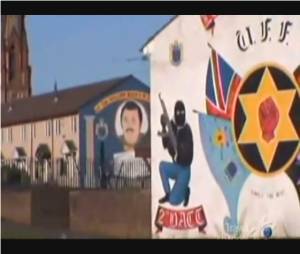 Shankill: Anthony hires John, a Protestant black taxi driver, for a tour of the Protestant enclave of Shankill. Anthony can't help but notice the predominantly militant theme of the murals.
Shankill: Anthony hires John, a Protestant black taxi driver, for a tour of the Protestant enclave of Shankill. Anthony can't help but notice the predominantly militant theme of the murals.
Falls Road: Then Anthony hires Patty, a Catholic black taxi driver, for a tour of Falls Road, a Catholic enclave. Again, Anthony can't help noticing the more peaceful and community oriented theme of the murals.
In recent times the area has become a tourist destination, with people wanting to see the site of some of the incidents that occurred during The Troubles and the many Republican murals that are now to be seen in the area. A popular destination is the Sinn Féin shop and office with its mural of hunger striker Bobby Sands. Another popular destination is the "solidarity wall", which features murals mainly dedicated to peoples/revolutionaries inspired by or with connections to Irish Republicanism (the Blanketmen, Palestinians, ETA, Frederick Douglass and so on).
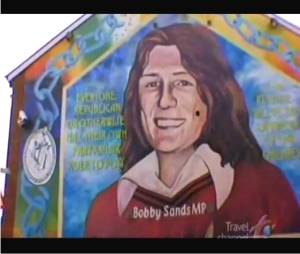 Crown Liqour Saloon: Anthony invites both John and Patty to join him for some traditional Irish fare and a pint or two of Guinness beer at the Crown Liqour Saloon. The Crown Liqour Saloon is an outstanding example of a Victorian gin palace and is Belfast's most famous pub. They dine on steak and Guinness pie and Irish stew, the three discuss how things are slowly getting better between the Catholics and Protestants in Belfast.
Crown Liqour Saloon: Anthony invites both John and Patty to join him for some traditional Irish fare and a pint or two of Guinness beer at the Crown Liqour Saloon. The Crown Liqour Saloon is an outstanding example of a Victorian gin palace and is Belfast's most famous pub. They dine on steak and Guinness pie and Irish stew, the three discuss how things are slowly getting better between the Catholics and Protestants in Belfast.
Cayenne Restaurant: Ireland is in the midst of an exciting culinary rennaissance Ireland and positioning itself to become the next culinary superpower. Anthony meets old friend, chef and restaurateur Paul Rankin in his Belfast gourmet restaurant, Cayenne. Cayenne is a bold fusion between Irish and Asian cuisine. Chef Rankin has worked all over the world before returning home with his fusion cuisine concept. His debut restaurant, Roscoff, was the first in Northern Ireland to receive Michelin star by the Michelin Guide. While the two friends catch up, they dine on an oriental appetizer plate consisting of salmon teriyaki, tempura prawns, sushi and Japanese-style ceviche, and a side of lobster-and-chicken wontons. Then the 2 main courses arrive: Irish beef filet with miso glaze, a wild-rice potato pancake, and asian-style herb salad; and an incredible loin of Irish lamb with spiced potatoes, cabbage and kimchi. They cap off the dinner with some Irish whiskey, which they both agree is the best in the world.
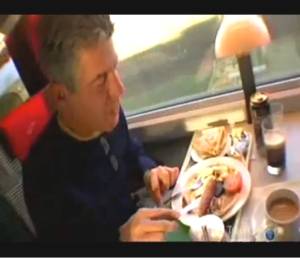
Commuter Train Dining Car: Anthony hops the morning train to Dublin, and enjoy the somewhat novel experience of eating a full traditional Irish breakfast with tea, and a pint of Guinness, as the Irish countryside flies by.
Moore Street Open-air Market: Back in his beloved Dublin, Anthony meets up with his old friend Cormet and the two tour the multicultural side of Dublin, passing the famous Moore Street open air market, Dublin's oldest food market.
Madina Asian Food Company: Anthony and Cormet stop for lunch at the Madina Asian Food Company and dine on tandoori chicken, vegetable samosas and pakoras, and a sizeable assortment of vegetable curries; not exactly traditional Irish fare, but one of the many signs pointing to Ireland's emerging multicultural status.
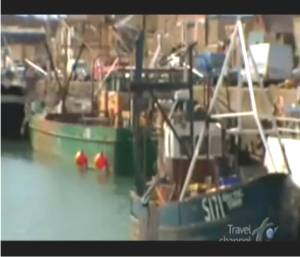 King Sitric Restaurant: Anthony visits the seaside village of Howth, just 20 miles outside of Dublin, where he meets up with his guide Patty for a seafood tour of the city. They dine at King Sitric restaurant, where the two enjoy a seafood bonanza of fresh periwinkles, clams, mussels, razor clams, scallops, Dublin Bay prawns, and Irish lobster, washed down with a good bottle of wine.
King Sitric Restaurant: Anthony visits the seaside village of Howth, just 20 miles outside of Dublin, where he meets up with his guide Patty for a seafood tour of the city. They dine at King Sitric restaurant, where the two enjoy a seafood bonanza of fresh periwinkles, clams, mussels, razor clams, scallops, Dublin Bay prawns, and Irish lobster, washed down with a good bottle of wine.
Rugby Match: Anthony travels to County Cork, where he meets up with Eddy Hogan and his teammates for a light game of rugby football. Rugby is a style of football that originated from Rugby School in the United Kingdom during the 19th century.
Ferguson Farm: County Cork has made a name for itself as the birthplace for the Irish Artisan Food Movement, as well as being the gastronomic capital of Ireland. Anthony visits mythical cheese and smoked meat producers, Giana and Tom Ferguson, who are true culinary pioneers in Ireland. Their pretty farm is located in the picturesque hamlet of Schull, where they make both artisan cheese with cows milk from their own herd and cured and smoked meats from their own pigs.
The Ivory Tower Restaurant: Anthony visits Seamus O'Connell, chef and owner of restaurant The Ivory Tower. Anthony assists as they make O'Connell's version of Irish blood pudding, incorporating tongues, sweetbreads, liver, roasted barley, a generous dose of lamb's blood, all encased in the bladder of a spring lamb (a milk-fed lamb, usually three to five months old, born in late winter or early spring and sold usually before July 1) that's coated in duck fat and roasted in the oven. It's then served with sautéed morels and shallots in a cream sauce.
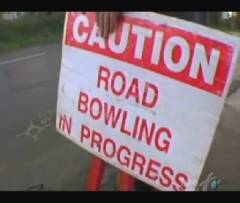 Road Bowling: Feeling inspired by County Cork's mile-after-mile of beautiful rolling countryside, Anthony decides to take a stroll when he happens upon one of its ancient and somewhat dangerous sport—road bowling. Anthony joins the hordes of spectators and gets in on the wagers. As Anthony and the spectators follow the players along the country road, he marvels at the enchanting countryside Cork County is so famous for. He can apprepriate why it has so inspired poets, writers, musicians, and cinematographers alike.
Road Bowling: Feeling inspired by County Cork's mile-after-mile of beautiful rolling countryside, Anthony decides to take a stroll when he happens upon one of its ancient and somewhat dangerous sport—road bowling. Anthony joins the hordes of spectators and gets in on the wagers. As Anthony and the spectators follow the players along the country road, he marvels at the enchanting countryside Cork County is so famous for. He can apprepriate why it has so inspired poets, writers, musicians, and cinematographers alike.
The basic premise of road bowling is similar to golf. Participants, usually single opponents, throw a 28 ounce iron and steel cannonball the size of a tennis ball (a "bowl" or "bullet") along a country road course, up to 2.5 miles long, the objective being to make it to the end with the least amount of throws. Participants in or from Ireland traditionally bet during the contest. Those who have bet on a player will follow that player around the course, giving advice.
Episodes:
 |
ARGENTINA: From the Tango to paragliding to cattle rustling to trekking along icy glaciers, Anthony experiences it all. |
 |
AUSTRALIA: Melbourne has been described as San Francisco without the fog. Anthony is off to discover what makes it so special. |
 |
BERLIN: Anthony finds himself in Berlin, a city that is for him both good and evil, Eastern and Western, repulsive and appealing. |
 |
BRAZIL: Some say São Paulo feels like LA threw up on NYC. But Anthony's back for the great food and its welcoming people. |
 |
CALCUTTA & BOMBAY: Anthony revisits his love for India's vibrant culture, cuisine & communities with a trip to Kolkata & Mumbai. |
 |
COLOMBIA: A bright and beautiful country that has gone from drug capital to food capital. Anthony explores its unique cuisine. |
 |
EGYPT: Anthony skips the long lines and tour buses, and visits with Egyptian locals to get a taste for what it means to be Egyptian. |
 |
GHANA: Anthony heads to Ghana, West Africa, a land of old forts and slave castles, and a culture filled with great food and music. |
 |
GREEK ISLES: Anthony is on a culinary odyssey to discover if Greece really does have the world's healthiest diet. |
 |
HONG KONG: A wonder-land of colors, lights and speed, a perfect marriage of modern and traditional, and home to great Asian cuisine. |
 |
JAMAICA: Jamaica is a vibrant, colorful land full of resorts and reggae music. Anthony is there to uncover the lesser-known Jamaica. |
 |
KOREA: Anthony gives in to his employee's pressure to visit Korea and, next thing you know, they're in Seoul and the adventure begins. |
 |
MEXICO: Carlos, a head chef in NYC and good friend, gives Anthony a culinary tour of his hometown Puebla and nearby Mexico City. |
 |
OSAKA (Japan): Anthony learns all about kuidaore, which means to bankrupt oneself with extravagance in food and drink! |
 |
PARIS: In this very first episode of the series, Anthony heads to the "City of Light" to show, at least the Americans, why the French don't suck. |
 |
PERU: Anthony is on a mission to obtain personal enlightenment in a land of ancient culture, rich cuisine, and vibrant people. |
 |
QUEBEC (Canada): Anthony is off to Québec to indulge in one of his most hedonistic pleasures–foie gras (fatty duck liver). |
 |
RAJASTHAN (India): From gorgeous sights to enticing smells, Anthony explores the magical and delicious offerings of Rajasthan. |
 |
ROME: Anthony adopts the mindset of the Roman people–living a simple life and eating fresh, seasonal ingredients. |
 |
RUSSIA: Anthony explores Russia, where the food is hearty. Along the way he meets a former Cold War spy and Miss Russia. |
 |
SHANGHAI (China): Anthony is back in China. From Shanghai to Tibet, he searches for the mythical Shangri-La. |
 |
SICILY: Anthony starts his gastronomic tour through Sicily in style by sharing a spleen sandwich with Sicily's president. |
 |
SINGAPORE: Singapore is serious about food and offers up a cuisine like no other. Anthony dives in head-first. |
 |
SPAIN: According to Anthony, outside of Asia, Spain is the single greatest place for culinary achievement in the world. |
 |
TOKYO: Anthony is off to Tokyo in search of the relationship between a perfect piece of sushi and a perfect knife blade. |
 |
TUSCANY: Anthony travels to the beautiful Tuscan countryside to visit with friends and enjoy some homemade pasta that's out of this world. |
 |
URUGUAY: Anthony and his brother are on a mission to connect with their roots in Uruguay after learning that Bourdains once settled here. |
 |
VANCOUVER (Canada): Anthony visits Vancouver, home to a thriving film industry, gorgeous scenery, and an evolving food scene. |
Contact Us | Shop | Sitemap | Join Our Team | Investors | Advertise | Web Design Services
Community | Foodies' Choice | Meetup Groups | Chat | Blogs | Forums | Submit Your Site | Resources

